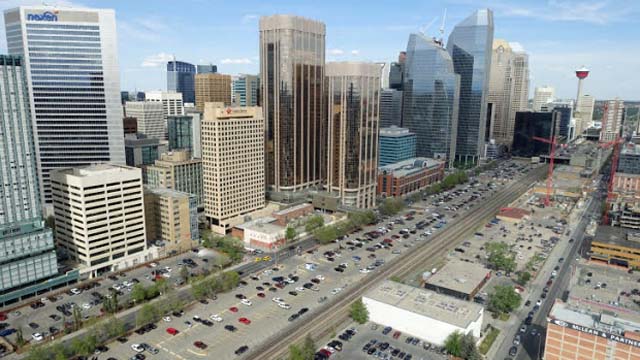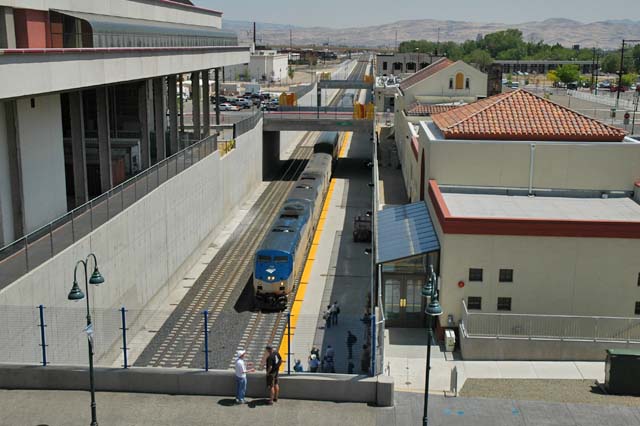
in Downtown Calgary
Calgary Alberta - It runs through the heart of Calgary like a steel spine.
The city was built around it and exists in no small measure because of it.
The track of the Canadian Pacific Railway (CP) is a fundamental part of Calgary's urban geography.
It is a daily factor in residents' relationship with the core of the city.
It bisects the core from the Beltline and runs through neighbourhoods.
It has become so familiar that its significance in shaping the city can be easily overlooked.
Yet now, in the wake of derailments, noise complaints, and visions of what the city's urban landscape should look like, Calgary's relationship with its railway
is again up for debate.
It's a complex situation with no easy answers.
Rail's First Spikes an Economic Boon
From the moment that the first spikes were driven, the rails have been an economic lifeline for Calgary.
CP has shaped Calgary's evolution more than any other corporation over the past 100 years.
Some might even say Calgary's entrepreneurial spirit is a legacy from CP's entrepreneurial vision of building a transcontinental railway more than
100-years-ago.
The massive, 64 hectare Ogden Yards, which opened in 1912, immediately became the largest employer, and stayed that way for decades as goods were shipped in
and out of the city.
At one time, all of the city's streetcar routes were organized to get workers to the yards.
The rails were also the main point of entry to Calgary.
The long-since-vanished CP station was where newcomers alighted to begin their lives in the city others just came to visit, staying at the purpose-built
Palliser Hotel next to the station.
In fact, CP once owned most of Calgary's downtown.
CP created the design of the familiar street grid still in place today.
And Stephen Avenue, Calgary's signature street, is named after Lord Mount Stephen, the first CP president.
Mount Royal was created as Calgary's first real estate community for CP executives, and the iconic Calgary Tower was built by a CP subsidiary in
1968.
For better or worse, the rails have shaped Calgary for a century.
As the economy prospered and the city grew up around them buildings like Gulf Canada Square, City Centre, and the Palliser Parkades, created a wall between
downtown and the Beltline.
But fast-forward to the early 21st century, and today the city of 1.3 million is renegotiating its relationship with the rails.
A New Relationship
What was a geographic scar through the city is being redesigned.
While once the land near the downtown tracks was mostly surface parking lots, today it has become construction sites for major new offices, hotels, condos, and
museums.
The Ogden Yard is now CP's head office campus, with four buildings being renovated, and the old locomotive shop converted into a 600 stall
parkade.
CP even operates differently within the city, as Coun. Gian-Carlo Carra has successfully championed a change that sees the railway cease work between 23:00 and
07:00 at its Alyth Yard in deference to peace and quiet in the neighbourhood.
But it is the question of safety that is the most fraught.
Coun. Evan Woolley and others have publicly questioned the movement of dangerous goods through downtown and the Beltline.
This, in light of disasters like the tragic derailment in Lake Megantic, but also derailments here in Calgary like the one at the Alyth Yard in
2013.
There may come the day when freight trains will not be allowed to pass through the middle of the city, perhaps the tracks might even be removed
entirely.
This would be a game changer for Calgary's city centre.
The idea has been floating around for awhile.
The Possibilities
In 2004, a team of city planners and community members worked together to develop a 100-year vision for what they called "Midtown."
That's south of the CP tracks to 13th Avenue S.W., from the Elbow River to 14th Street S.W.
When it came to the railway, the ambitious plan identified some competing ideas that would make the Midtown district a vibrant place to live work and
play:
- Leave the tracks as they are;
- Raise the railway line slightly to permit better access north and south;
- Eliminate the tracks altogether;
- Bury tracks underground.
OKthePK Joint Bar Editor: How about a Reno Trench for starters? You can cover it later.

Interesting ideas.
But easier said than done.
Who Would Pay to Move Tracks
David Watson, general manager of Calgary's planning, development, and assessment department, said at the time, "The bottom line was the cost of moving the
tracks was prohibitive."
CP's position was somebody else would have to pay for all the relocation cost and they would still retain ownership of the land.
That turned out to be a non-starter.
So the conversation quickly turned to how to make the tracks work better by creating better underpasses, redeveloping the surface parking lots, and addressing
safety issues.
Even this takes big money.
Part of that strategy has been implemented with the enhancement of existing underpasses at 1st and 8th Streets S.W., at a cost of more than $10 million, and
the construction of a new, $70 million underpass at 4th Street S.E. linking East Village to Stampede Park.
But is this enough? There's still an argument about removing the tracks altogether.
The big idea from the Midtown Urban Design Strategy was the transformation of 10th Avenue South into a pedestrian friendly "grand boulevard" with a
streetcar that would link Millennium Park and the Bow River on the west with the Stampede Park and the Elbow River on the east.
Sounds lovely until you crunch the numbers.
It would cost billions and could take decades.
Even if you could just dig up the main line, it's linked to an entire network of sidings in the Calgary region, which would also have to be
reconfigured.
Would those billions be better invested in other infrastructure improvements?
But wait!
There are other options.
The past could become future.
Passenger Rail and Transit
In fact, relocation could be the worse option, as the tracks could be critical to the region's future transportation plans, as we wean ourselves off the
automobile.
Peter Wallis, president and CEO of the Van Horne Institute at the University of Calgary, notes "the tracks are an important part of future plans for
Alberta's high-speed rail link," which his institute has been championing for years.
And discussions have also been ongoing about the feasibility of the CP track right-of-way being used for future commuter trains from Canmore and Cochrane to
downtown Calgary.
Also possible are commuter trains from the north and south like the GO Train in southern Ontario.
This raises the tantalizing possibility of Calgary once again having a major downtown passenger railway station.
This would take the combined efforts and agreement of the city, CP, developers, and community members.
But perhaps this moment, when oil has bottomed out, is the time to do it.
Downtown Opportunities
Francisco Alaniz Uribe, at the University of Calgary's Urban Lab, says "we should use the current pause in our city's growth to develop a private/public
partnership to determine what is the biggest and best future use of CP's city centre corridor for private and pubic uses."
And certainly there seems to be more infrastructure money floating about these days, as governments look to boost Calgary's economy.
Uribe acknowledges the huge economic and engineering challenge presented by changing the tracks, but he thinks Calgary has a chance to imitate other cities
faced with the same challenge.
He's for spending the money to boost the economy and bury the tracks.
As he says, this would create a continuous public realm at street level between 17th Avenue and the Bow River, which would represent the greatest gain for the
public.
This could allow Calgary to create something with grandeur, like New York City's Hudson Yards, or Chicago's Millennium Park in the future.
Whether now or later, for esthetic or safety reasons, speculating about the future of the CP tracks is sure to continue.
It's just another example of how, while in Calgary we can find ourselves at a crossroads, our visionary nature continues to create a world of
opportunities.
Richard White.



